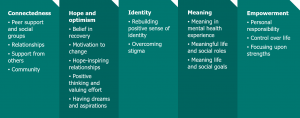Personal recovery
Key findings
- The construct of ‘recovery capital’ is used to refer to the resources available to support a person in their recovery journey. Three types of recovery capital have been identified: personal, family/social, and community.
- The CHIME framework for personal recovery covers five components of effective recovery-oriented services and interventions: Connectedness, Hope, Identity, Meaning and Empowerment. These components have been found to be prevalent across the research literature.
- There are strong overlaps with the findings from the desistance research – recovery and desistance is different for each individual and is typically a gradual, non-linear and multidimensional process. Both research areas highlight the importance of social context and connections.
Background
The personal recovery literature encompasses recovery from substance misuse and mental health difficulties, which can be co-occurring. Addiction recovery has been defined as having three dimensions:
(i) control over or cessation of problematic substance use
(ii) improvements in global health and wellbeing
(iii) active participation in and a contribution to community or society.
The construct of ‘recovery capital’ is used to refer to the breadth and depth of resources available to an individual to support their recovery journey. It reflects a shift in focus from the pathology of addiction to a focus on the internal and external assets required to initiate and sustain long-term recovery.
The Acronym CHIME (Connectedness, Hope, Identity, Meaning and Empowerment) was initially developed in relation to the key components of effective recovery-oriented services within mental health services and interventions. This has been translated into a Chime in Action model in which positive social connection is seen as the critical starting point for the initiation of recovery. The goal is to create a virtuous circle of positive social support and positive identify predicated on active participation and engagement in activities that promote and support recovery.
The video below, produced by the Scottish Recovery Network, explains the CHIME recovery framework.
Disclaimer: an external platform has been used to host this video. Recommendations for further viewing may appear at the end of the video and are beyond our control.
Summary of the evidence
Types of recovery capital
Three types of recovery capital have been identified:
i. personal recovery capital – including physical capital such as health, financial assets, safe and recovery-conducive shelter, clothing, food, and access to transport; and human capital including an individual’s values, knowledge, educational/vocational skills, problem solving capacities, self-awareness, self-esteem, self-efficacy, hopefulness/optimism, perception of one’s past/present/future, sense of meaning and purpose in life, and interpersonal skills
ii. family/social recovery – including intimate, family, and social relationships. It is indicated by the willingness of intimate partners and family members to participate in treatment, the presence of others in recovery within the family and social network, access to leisure activities, and relational connections to conventional organisations
iii. community recovery capital – encompasses community attitudes/policies/resources related to addiction and recovery that promote the resolution of an individual’s problems. This includes a good range of treatment resources, interventions and community support institutions, active efforts to reduce stigma, and visible and diverse local recovery models.
The benefits of social support for recovery – which may take the form of information or practical assistance, emotional support, and a sense of belonging – have been reported to be dependent on the degree to which those providing support are perceived to be relevant, similar, and connected to the individual.
CHIME components and factors
A literature review focusing on personal recovery from mental health difficulties found 13 characteristics of the recovery journey, clearly demonstrating that recovery is different for each individual and can come about in a variety of ways. It is typically a gradual, non-linear and multidimensional process, with differing stages or phases. The CHIME factors were prevalent across the research. The descriptions of the processes involved in each factor is shown in the figure below.
Overlaps with the desistance research
The importance of social and societal factors for sustaining recovery is now clear, encompassing social connections, groups and networks and social learning, identity effects and control. The reasons for recovery being sustained over a period of time have been reported to be overwhelmingly social, with moving away from networks where people have addictions and towards pro-recovery social networks seen as key. There are obvious overlaps with the desistance literature, which similarly highlights the importance of social context and connections.
All the other CHIME factors can similarly be found in the desistance literature, with both research areas highlighting that the processes are neither quick or easy, and often involve setbacks. It is a personal journey requiring an individualised approach.
Best, D. and Laudet, A. (2014). The potential of recovery capital. London: RSA.
Best, D. (2019). Pathways to desistance and recovery: The role of the social contagion of hope. Bristol: Policy Press.
Cano, I., Best, Edwards, M. and Lehman, J. (2017). ‘Recovery capital pathways: Mapping the components of recovery wellbeing’, Drug and Alcohol Dependence, 181, pp. 11-19.
Leamy, M., Bird, V., Le Boutillier, C., Williams, J., and Slade, M. (2011). ‘A conceptual framework for personal recovery in mental health: systematic review and narrative synthesis’, British Journal of Psychiatry, 199(6), pp. 445–452.
White, W. and Cloud, W. (2008). ‘Recovery capital: a primer for addictions professionals’, Counselor, 9(5), pp. 22-27.
Back to Models and principles Next: Supervision skills
Last updated: 18 December 2020




